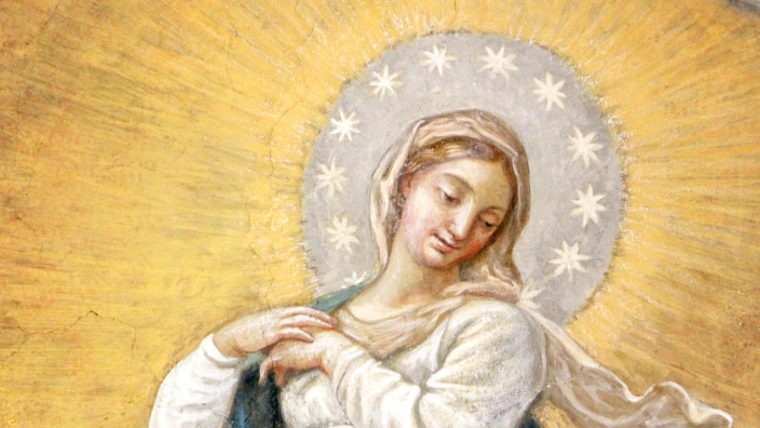Et in capite eius corona stellarum duodecim. Apoc. XII – On her head a crown of twelve stars
The evangelist St. John saw in Patmos other adornments of the immaculate woman. Just as at the virginal feet of the queen of the universe the moon is noble and a sovereign stool, so the stars in a mystical number intertwine on her kind head and her shining crown. In those twelve stars are represented the Fathers, those twelve Apostles, custodians of the doctrine, and the example of all holiness, which from Jesus Christ, and in Jesus Christ, in us is derived, nourished and fulfilled. These twelve Christianised the world by the example and the rule of his holiness, validated by the virtue of miracles; and confirmed thus in the grace of the Holy Spirit they were the twelve columns from which was to rise up the spiritual edifice of human regeneration; and it was the twelve stars that were to point out the way of navigators in this stormy sea, where even error had penetrated, and the shadows of ignorance dominated…Those twelve were to be become the channels by which to transmit to nations the same virtue of incarnated divinity, but in the order, above the senses, of grace. There came instead into existence this Immaculate woman to give to the earth in the order of human nature the author himself of every grace and every holiness. Thus worthily the most sublime stars of holiness that shine brightly in the heaven of the Church of God come to be a crown for her who rises above them all, and by a great measure exceeds them.
GO ON READING
Follow in PDF all of the text
From I Gigli di Maria, a Neapolitan periodical. Year III 1866
Fr. AGOSTINO LANA (Camillian)
He was born in Rome on 23 May 1821. From a profoundly Christian family, he was brought up according to the precepts of divine love. He entered the Order of the Ministers of the Sick in 1841. He was ordained a priest in 1845. A true Minister of the Sick, we find him working in isolation hospitals and at the side of the dying. He was a Provincial Prefect and a member of the General Consulta. A member of the Academy of the Arcadi with the name of Filete Eereo, for about thirty years he was an assiduous and conscientious member of the consulta of the Sacred Congregation of Rites. A profound theologian, he was markedly expert in sacred and profane history and Christian archaeology. He died in the House of San Giovanni della Malva in Rome on 22 October 1901.
He stood out for his devotion to the Most Holy Virgin. Many of his writings were published in the periodical of Naples, I Gigli di Maria, to which he was a valuable contributor.
On 20 December 1845 he was consecrated a priest.















Camillians on Facebook
Camillians on Twitter
Camillians on Instagram